How to choose a stand up paddle board
Jan 26, 2020
Stand up paddle boarding (SUP) continues to grow in popularity as a simple and versatile way to take to the water. But, if you decide to invest in your own SUP, how can you choose the model that’s best for you? It’s important to consider the types of paddle board, your experience and planned adventures.
TYPES OF PADDLE BOARD
The different types of paddle board on the market can be overwhelming. But don’t worry, we’re here to take you through the primary types that you will find.
ALL-ROUND
All-Round paddle boards are the most common paddle board type and are the perfect choice for beginner paddlers. With a focus on stability, they are – as the name suggests – versatile in all conditions. However, they are best suited to flat water, such as lakes and ponds.
Despite their typically larger width compared to other types of paddle board, they still offer decent manoeuvrability.
An added advantage is that these paddle boards are family (and dog!) friendly.
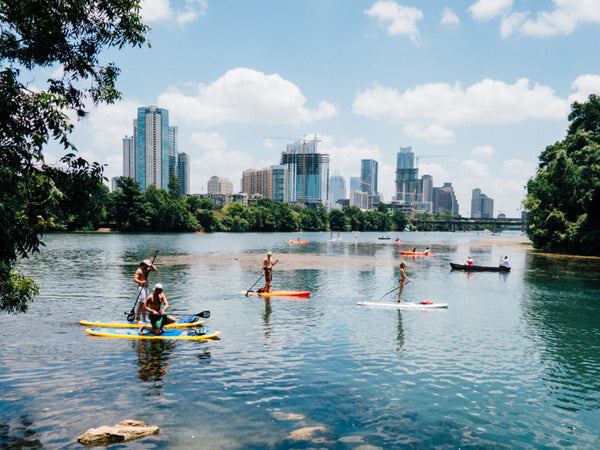
All-Round paddle boards are best suited to flat water conditions
TOURING
Touring models are a step-up from the All-Round models – the right choice for intermediate and expert paddlers who cover long distances in the water.
If you are looking to tour in bays, large lakes and oceans, Touring paddle boards are constructed to maximise gliding and efficiency. Their displacement hull allows them to glide on the water and carry more speed over long distances.
If long-distance paddling is your thing, then choose a Touring board.
RACING
Racing paddle boards are made for paddlers who want to get their heart rate up and move quickly through the water.
These boards tend to be slimmer with a tapered nose, reducing the drag and increasing glide across the water’s surface.
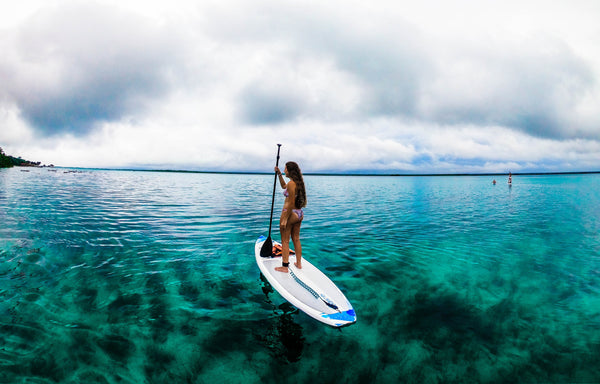
SURFING
If racing isn’t for you, but surfing the waves is, then choose a Surfing paddle board. For paddlers who are looking for more action, these boards are suitable for intermediate to advanced paddlers, as they offer less stability than All-Round and Touring models.
These boards tend to be thinner than other paddle boards, and offer a shorter frame to make them more versatile. Their rounded pintail allows for quick pivot turns, making them highly manoeuvrable on the waves.
An additional advantage is that their lighter weight also makes them suitable for children.
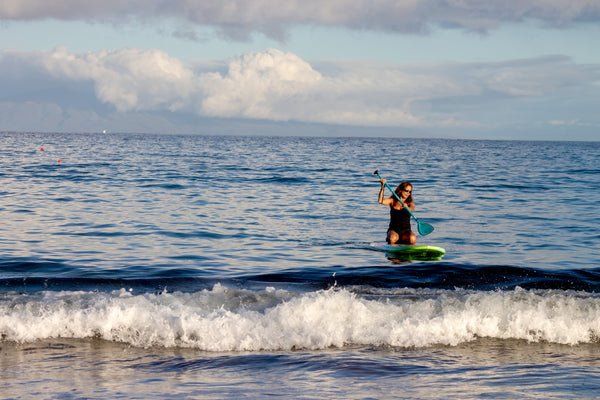
Surfing SUPs are for intermediate to experienced paddlers looking for more action
YOGA
For those looking to take their yoga practice onto the water, Yoga paddle boards are designed for just that. Constructed for stability on calm water, these boards offer expansive deck pads to provide extra room for yoga.
With deck pads designed to offer superior grip in the water, smooth finishes also mean they won’t dig into your knees or palms.
This paddle board shape is also suitable for flat water paddling and fitness-related exercise.
INFLATABLE
All of the above types of paddle board are available in epoxy and inflatable models.
The advantage of inflatable paddle boards is that they’re portable and affordable. They inflate in a matter of minutes and, when deflated, they pack down to the size of a sleeping bag.
If you’re looking for portability, durability, and value – then an inflatable board will be your go-to.

Inflatable paddle boards offer durability, portability and value
SIZE OF BOARD
Now that you know what type of board you’re looking for, it’s time to pick the right size.
You should consider your weight and paddle boarding experience when choosing the correct size for you. You’re looking for enough buoyancy (volume) to properly float you. The wider, longer and thicker the board, the more capacity it will have and the more stable it will be on the water.
If a paddler is too heavy for a board, it will sit lower in the water and create more drag. You don’t need to worry about being too light for a board.
Beginner paddlers will usually want a higher-volume board, as this provides additional stability. As your skill level improves, you can downsize to a board with less volume, or a more activity-specific board like those mentioned above.
Consider length, width and thickness when choosing the right board for you. You can use our size guide for an easy comparison between board sizes and types.
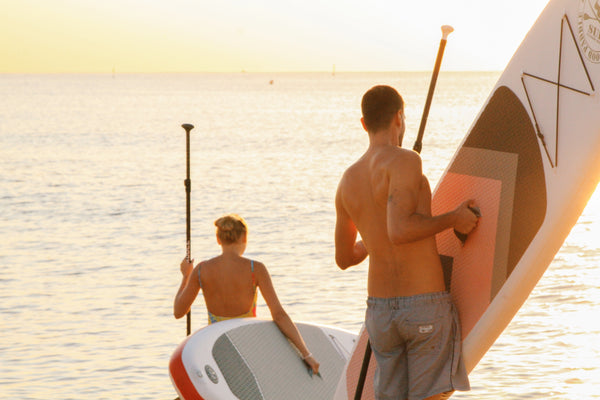
EXPERIENCE
Your level of experience also plays an important role when choosing your board.
BEGINNERS
If you’re a beginner paddle boarder, you will likely prefer a wider, more stable, stand-up paddle board. Inflatable and All-Round SUP models are the most popular for those starting out in their paddle boarding career, as they also offer versatility in terms of paddling location.
EXPERIENCED
An experienced paddler will have spent a significant amount of time honing their skills, and will likely have identified their favourite paddling locations.
For some more experienced paddlers, their focus will be on speed and efficiency – leading them to a lower volume or Racing SUP. Others are more activity-based, looking to take to the waves or practice yoga on the water.
Whether paddling on flat or choppy water, experienced paddlers can handle it all with the right board.
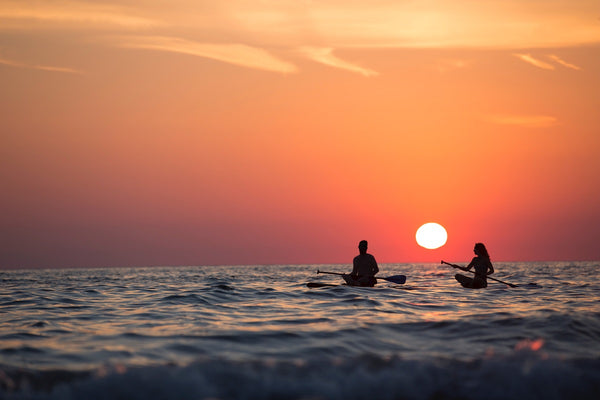
DIGGING DEEPER – HULLS AND FINS
For more experienced paddlers, you may also want to consider the types of hulls and fins available.
HULLS
The design of your SUP’s hull will determine how it performs in the water. There are two common types of paddle board hulls:
- Planing Hull: A planing hull is much like the bottom of a boat – the board slightly tapers off towards the edges. This is particularly manoeuvrable and stable, making it a good choice for casual paddling and surfing.
- Displacement Hull: A displacement hull has a sharp pointed nose, allowing the hull to slice through the water, providing a fast and smooth ride. This makes it the right choice for paddlers wanting to cover long distances. Therefore, most touring boards are designed with a displacement hull.
FINS
There are several types of fins used on paddle boards, but how do these affect performance and user experience?
- Large single fin: Best for versatility, this is a large single fin placed in a finbox and secured with a nut and screw. When the fin is pushed towards the tail, the board will track better – good for racing, touring and flat water. When pushed towards the nose, the board will turn more easily – better for surfing or white water.
- Three-fin: This set-up was originally designed for surfing, but also works on flat water.
- Race fins: These come in a variety of types. Some have a rigid shape, which are best for downwind runs as they help longer boards track better in large wind waves or swell. However, if you hit a rock, you will likely fall over. Other fins offer more flexibility, and will bounce off obstructions.
- Inflatable SUP fin: Inflatable SUP fins are either flexible rubber fins attached to the board or detachable semi-rigid fins.
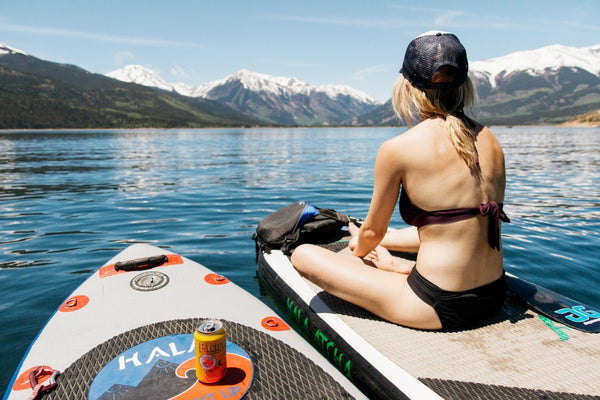
STORAGE
Many paddlers are concerned about storing their SUP when they’re not out on the water.
Inflatables are perfect for people short on space. Regardless of the board size you have, you’ll be able to deflate it to store it practically anywhere.
You will need to keep all paddle boards stored out of direct sunlight, because it can cause epoxy SUPs to delaminate and can potentially ruin the seams of inflatable boards.
PRICE
As you’re likely to have discovered in your paddle board research, the prices can range from as little as $400 to more than $2000. Price point is an important consideration for many paddlers.
BASIC BOARDS
Boards priced below approximately $500 will sacrifice quality, materials and design to achieve this low price point. Be wary of these boards if you want to ensure yours goes the distance and lasts longer than a summer.
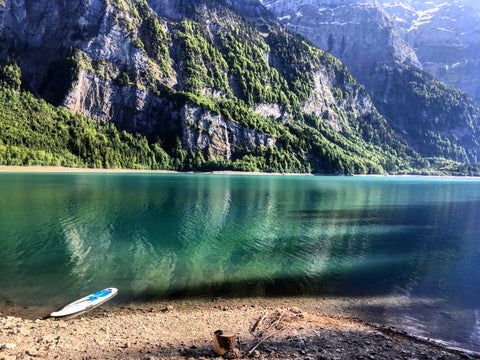
PREMIUM BOARDS
Bay Sports boards fall within the Premium category and there are several reasons why this is important:
- Glue: Our boards use a premium high-grade glue, which is not only the strongest available but also environmentally friendly.
- 3-year warranty and 30-day paddle guarantee: We guarantee your board will stay in good shape for years to come with our industry-leading 3-year warranty. We’re so sure that you’ll love your board, you can paddle it as much as you like and, if you don’t completely love it, return it for a refund. No questions asked.
- Premium materials: Many inflatable SUP boards are advertised as lightweight, but it can be at the disadvantage to the stiffness of the board, meaning your board may suffer from the wobble effect. Bay Sports use premium reinforced PVC which allows us to reach unparalleled stiffness whilst also producing a very lightweight board.
- Included accessories: The included accessories are a step above the rest, including a Helios triple-action pump and fibreglass paddle.
- Factory direct to you: Most of the big name brands you see advertised for $1500-$2000 are priced so because they sell through distributors, who sell to retailers, who sell to you. By being the manufacturer and selling direct to customer, we are able to cut out the middleman profits, allowing you to purchase the highest quality board package for significantly less.
Looking for your perfect paddle boarding partner? Explore our full range of inflatable stand-up paddle boards.

